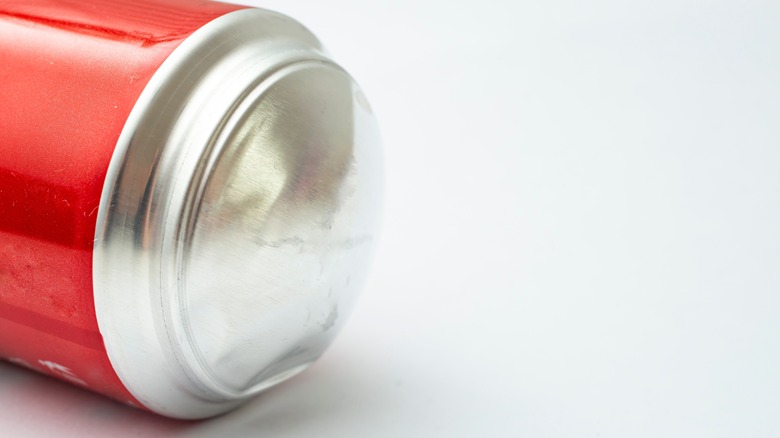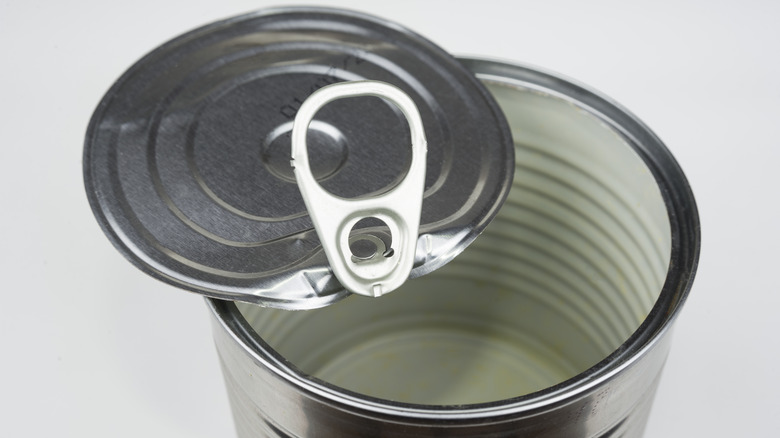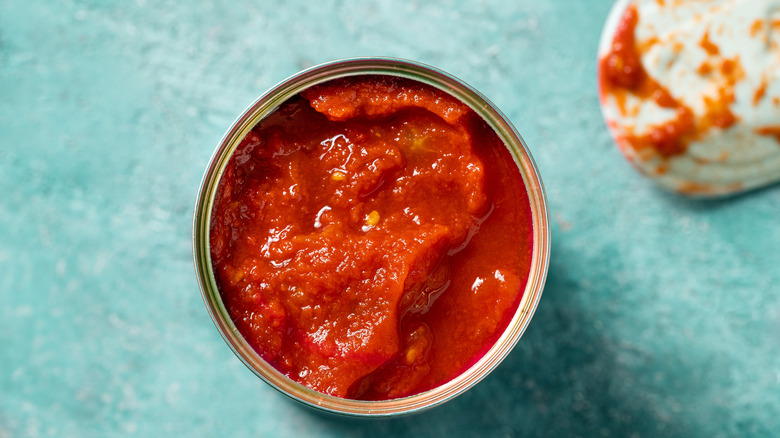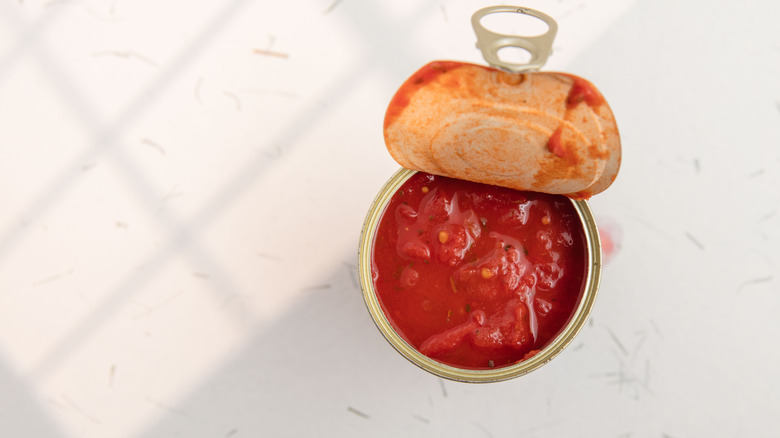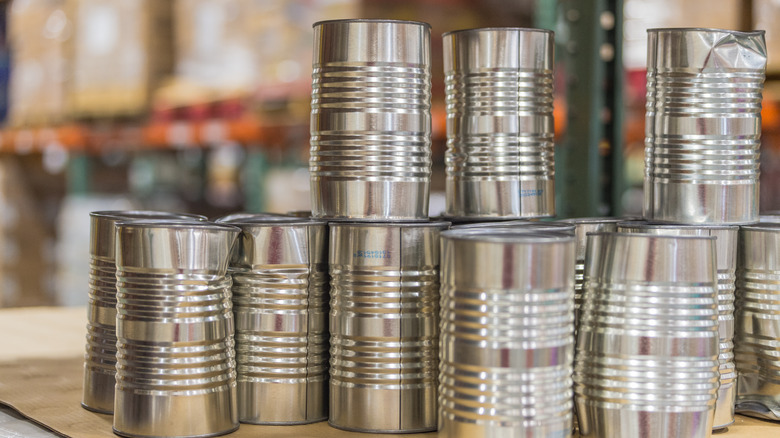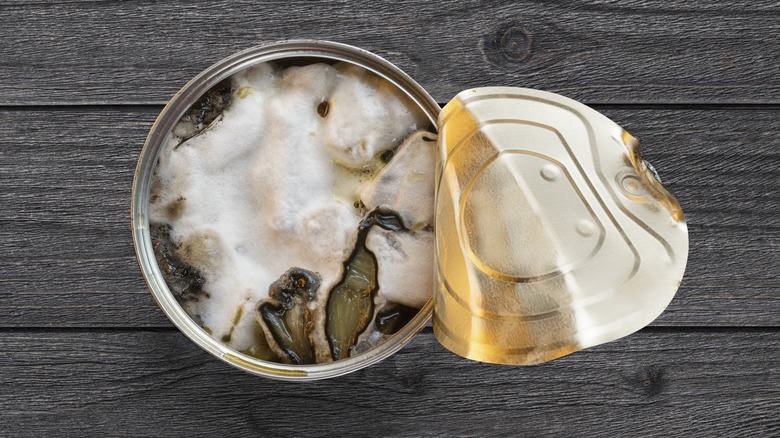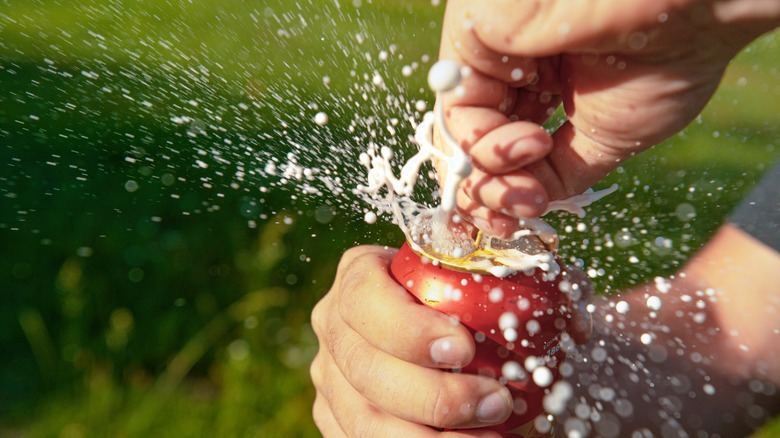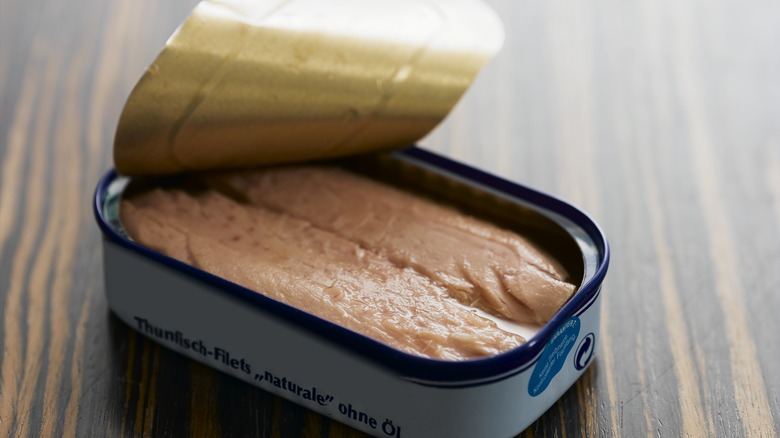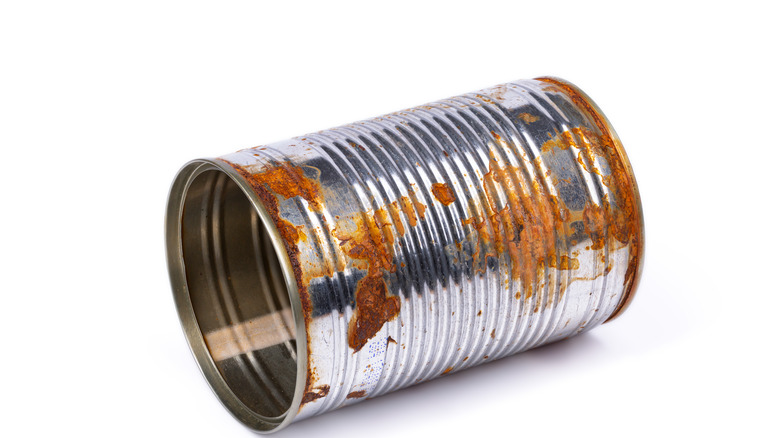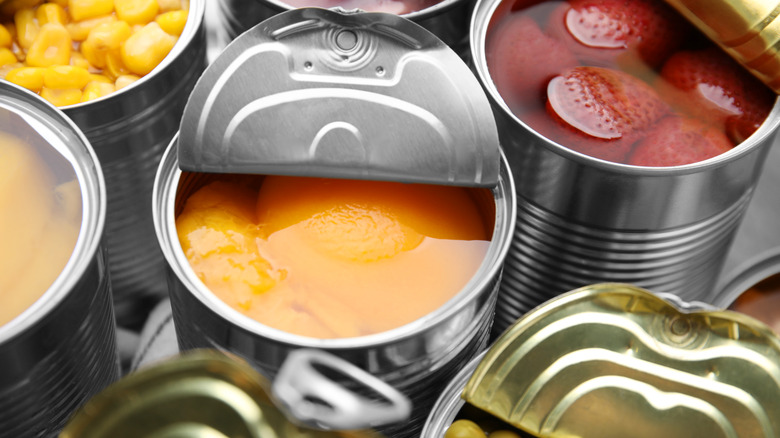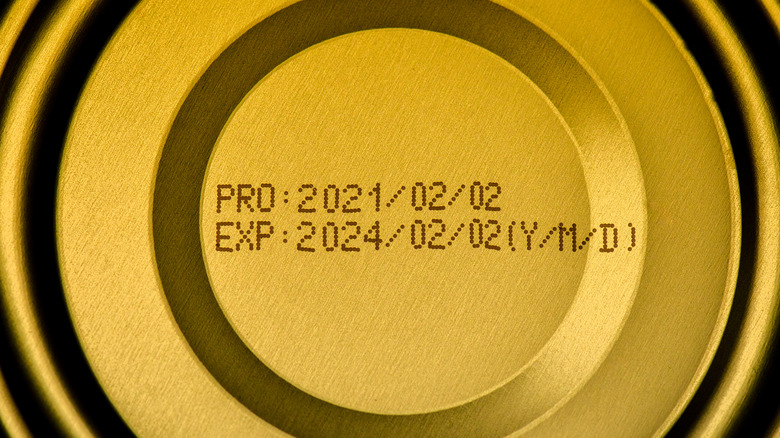11 Signs Your Canned Food Has Gone Bad
One of the most resourceful inventions of modern day packaged goods is canned foods, easily available, compact, affordable, and still a nutritious food choice despite the lackluster appearance. Canned food has become a staple in the American diet, as they're a convenient option for quick dinners that are also filling and delicious. It's easy to see where all the love pours in from.
However, with love for canned food comes risks we can't look away from, as canned food isn't free from a risk of spoilage, much like fresh food. Although it's a more shelf-stable option, canned food can be contaminated from the outside environment via bacterial growth, leading to food poisoning or botulism if such contaminated food is consumed. That's why it's important to look out for the signs of canned food spoilage, including dented, rusted, or swollen cans, as well as those which give off an unnatural odor or have mold growing. If you come across canned food with signs like these and more, it's best to discard the food.
To round up all the signs and ways to identify canned food spoilage, we spoke to experts in the field on telltale signs to watch out for. Our panel included nutritionists, diet consultants, and a chef, whose expertise reveals the most common and uncommon ways to identify canned food spoilage.
1. The can is bulging or has swollen areas
Food cans are notoriously easy to misplace in the pantry. They'll get chucked behind a family-sized jar of peanut butter and you'll miss them for months, until you finally move around some stuff and spot them. By then, it's possible your can has acquired an odd-looking shape, with swollen and bulging areas. Dr. Nicole Avena, a nutrition and diet consultant, and author of her new book "Sugarless," tells us this is the result of a negatively impacted product which has become spoiled owing to microorganism growth, which builds pressure inside the can, causing it to swell.
It goes without saying that a rather odd looking can should be discarded immediately, but Dr. Chris Mohr, a nutrition advisor for Fortune Recommends Health, tells us the reason. "Bulging can often suggest that harmful bacteria inside are producing gases, which can lead to serious illnesses like botulism," he says. The Centers for Disease Control and Prevention (CDC) categorize botulism as a serious medical emergency which is caused by a toxin harming the body's nerves, and leading to muscle paralysis, breathing difficulties, and potential death. Foodborne botulism is the reason reheated potatoes could make you sick, and is also caused by canning food improperly at home, and it's uncommon but not unheard of in store-bought food. So the next time you spot a can of tomatoes looking anything less than can-shaped, it's best to chuck it in the trash even before opening to check the contents.
2. The can has an unsealed or a broken lid
Canned food is often considered highly shelf and pantry stable, so it's easy to improperly store and mess up the contents. Cans need a pretty specific storage environment to extend their shelf life, which primarily comprises of a cool and dry spot away from direct sunlight. Dr. Chris Mohr says it's best to keep your canned food away from any particularly warm places, as hot temperatures can damage the can, causing its seal to break. However, this doesn't mean cooling down the can, as you shouldn't store canned food in the refrigerator, since extreme temperatures on either end are bad for canned food. Moreover, a broken seal invites bacterial growth in your canned food, resulting in contamination which can lead to foodborne illnesses if the spoiled contents are consumed.
Dr. Nicole Avena helps us define the exact storage conditions that can keep canned food safe. "It is best to store canned goods in a dark/dimmed area that is dry with temperatures below 85 degrees Fahrenheit," she says, adding that heat increases the risk of spoilage for canned food. The United States Department of Agriculture's (USDA) food safety and inspection unit explains that the canning process introduces a vacuum seal which prevents bacteria from entering or spoiling the contents. However, when the container is opened, whether intentionally or by breakage, the seal is no longer intact and can't protect the contents any longer.
3. The canned food gives a rotten, acidic, or metallic smell
When determining the state of your canned food, smell is the first and strongest indicator of spoilage. However, the smells that indicate canned food having gone bad are specific and easily identifiable. Our experts helped us identify a few, "Unpleasant smells from spoiled canned food vary from sulfurous smells resembling rotten eggs to generally foul or off aromas," says Dr. Chris Mohr. According to chef Chris Aquilino, director of culinary at Elior North America, acidic smells are also a red flag when sniffing out your canned food, which he describes as sour or vinegary. He also mentions that a yeast-like or alcoholic smell coming from a can indicates spoilage, but can be tricky to pinpoint immediately since we've grown accustomed to such smells.
Dr. Nicole Avena advises the same, and also mentions watching out for a metallic smell. "The nose can become a very useful tool in determining if a canned food item is safe to consume — so don't be afraid to use it," she says. Smell is a pretty obvious indicator of canned food spoilage, and not all signs are so clear, so don't contemplate if the smell of your can is different from the ones described above, and if it feels off, throw the can out right away.
4. There's dried food or sediment near the top of the can
Most people that can their food at home will have faced the problem of sediment formation inside the cans. Many foods release a natural sediment, such as tomatoes, onions, spinach, and other green vegetables, so it's not always an indicator of spoilage. However, chef Chris Aquilino tells us that the placement of sediment in the can helps determine if the food has gone bad or not, as scattered sediment throughout the container is a red flag while the type settled at the bottom is not.
Natural sediment in foods like canned tomatoes is fine, but when paired with other indicators of canned food spoilage like an acrid smell or a dented container, it becomes a sure sign that your canned food is past saving, opines Dr. Nicole Avena. "In these situations, it is always best to use other indicators of spoilage to differentiate between what is naturally occurring and what may be a sign of spoilage," she says.
5. The can has visible and deep dents
Finding a dented can at the grocery store is not an uncommon occurrence, as the cans are transported from a few locations before they reach you, which can lead to some cans getting misshapen along the way. Dr. Chris Mohr explains that the canning process is where the problem can arise, if proper sanitation and sealing methods aren't adhered to, followed by improper handling. "One of the biggest issues is transport and storage," he says, adding that "severe temperature swings and damage while moving are a huge issue." He suggests preventing denting in cans during transportation by not packing them too close together, since the proximity can cause damage to all of them.
It's also important to note that a dented can doesn't guarantee that the contents have gone bad, but like with sediment, if dents in your can occur with other signs of spoilage, it's better to discard the product entirely. The United States Department of Agriculture (USDA) helps identify the type of dents to look out for in cans, such as a deep dent in which you can lay your finger, a sharp or pointed dent, or one on the seam, as they can be gateways for bacteria. Smaller dents on a can that otherwise seems fine is safe to consume. So you can easily avoid getting a dented can by keeping a lookout while purchasing them at the store, and feel the can out to ensure there are no dents.
6. The food has an unnatural color and mold growing inside
One of the more obvious signs of canned food spoilage is mold growing on the contents inside. However, this sign is visible after you've opened the can, at which point some might be tempted to remove the mold and consume the remaining contents. Doing this is never a good idea, as the Ohio State University's College of Food, Agricultural and Environmental Sciences recommends throwing out moldy canned food immediately, due to food safety issues which can arise from the mold. These include the mold digesting the canned food's acid and raising the pH, which can increase the risk of botulism. Problems with canning can also be the reason for mold growth, such as a weak seal, contamination on the rim, under-processing, and poor vacuum among others.
Dr. Chris Mohr recommends watching out for an unusually dark or faded appearance on the canned food, which can indicate mold. There are also some specific colors you need to watch out for to be sure if the discoloration is from mold or not. "When examining canned food products, it is important to pay attention to the color. Any unnatural colors such as white, blue, black, or green may be indicative of mold," says Dr. Nicole Avena. In case your food has acquired any such unnatural hues, she recommends disposing of the can and its contents immediately.
7. There are foamy bubbles or fizzing inside the can
If you've consumed canned food often, or even tried your hand at canning, you're no stranger to the presence of bubbles on the food's surface or inside. Especially when canning at home, you might wonder if bubbles in your canned food are a red flag, but smaller, unmoving or benign ones are usually harmless. However, if the bubbles are moving, fizzing, or rising to the surface when the can is opened, this is a sign the contents have become tainted.
Dr. Nicole Avena points out that foamy bubbles in your canned food are a red flag to watch out for, since they're a definitive way of knowing the food isn't safe to consume any longer. Fizzing like a soda on opening the can is an even more conclusive indicator that the canned food has gone bad, according to chef Chris Aquilino, and should be thrown away to avoid ingesting a contaminated product.
8. The food has a slimy, mushy, or squishy texture
Canned food will naturally not be that robust, and have an altered texture compared to the fresh kind, but its overall appearance and feel should be pretty uniform. However, just like with fresh food, spoilage can alter the texture of canned food as well, making it mushy or soft. Some foods are more likely to get these textural changes than others, especially highly acidic foods like tomatoes, salsa, and pickles, which contain chemicals that react with the can's lining to change its composition over time. This is the reason why your vinegar's acidity matters in canning food. So an overly soft or unnatural texture is one of the telltale signs your canned food has gone bad, and should be thrown away.
Dr. Nicole Avena mentions that if the food has a slimy or squishy feel to it (more so than it naturally has) then the food is likely spoiled. In such cases, it's important to keep an eye out on the more acidic food cans in your pantry to ensure they don't go bad over time, and discard them if there are visible textural changes.
9. The can has rusted or shows areas of corrosion
Finding rust on cans that have been in your pantry for a while is a common occurrence and can appear natural, but it's important to pay attention to where the rust is located and its extent. Our experts highlight rust or corrosion as one of the more obvious signs of canned food spoilage. Dr. Nicole Avena recommends storing your cans in a dry place, away from moisture, which is one of the easiest ways for cans to corrode. "It is best to also prevent excess moisture as it can lead to corrosion, which may result in defects to the can and allow microorganisms to impede," she says.
The USDA recommends throwing out massively rusted cans as they can develop small holes that allow bacteria to get inside. If there's rust on the can's surface only, you can easily remove it by rubbing it with a cloth, as not cleaning your canned food is one overlooked mistake you can make when opening canned goods. But if you find the rust has made its way to the food inside on opening the can, that indicates contamination since rust is not food safe.
10. There's leakage in the can
One of the many problems that can arise in canned food from improper canning, handling, and storage is leaking. You might have come across a leaking can, and oftentimes, the source or cause of the leak isn't immediately evident. That's because leakage occurs from small punctures, pinholes, or poor seams on the can. Leakage due to these reasons as well as underprocessing the can causes spoilage as microorganisms enter the product. Contaminated cooling water can also enter the cans from the punctures, causing spoilage as bacterial growth takes place.
When asked about the most common signs of canned food spoilage, our experts unanimously agree on leakage being a primary cause. It may not immediately be apparent to most people, as you may mistake it for condensation or moisture from another product having touched the can. But in case the leakage is more evident, it's better to get rid of the can and not risk opening it to check in case the spoilage is worse inside.
11. The product is well past the expiration date
Before getting into the debate of food safety dates, it should be noted that an expiration date is different from a best-by date. Chef Chris Aquilino notes that an expiration date is carefully selected by the manufacturer and should be treated more seriously, as opposed to a best-by date which determines food quality. Moreover, Dr. Chris Mohr notes, "Expiration dates are useful for gauging food quality, but they're not always a strict safety cut-off. If the can appears intact but the date has passed, be cautious." That's why the idea that canned food shouldn't be consumed after its use-by or best-by dates is one of the most common canned food myths.
On this matter, Dr. Nicole Avena sheds light that these dates are not set or required by the government as an integral part of food labeling. She says, "Per the USDA, 'dating is for quality, not safety.' With this, the USDA outlines that a shelf-stable product can be safely used after the indicated 'sell-by' date." However, she also mentions that per the USDA's outline, canned food or any product which has crossed these dates will have an overall lower quality than before.

